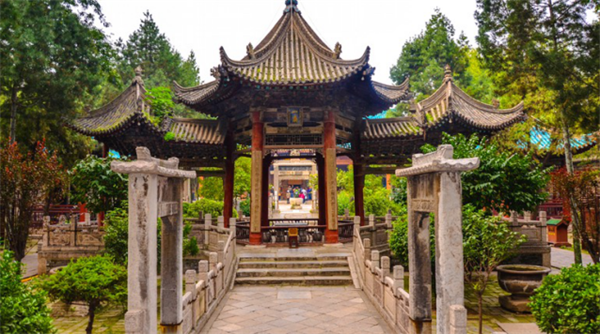Great Mosque
2021-10-26 15:13:00 , Source : The Government Website of Shaanxi Province
Bigger than many temples in China, the Great Mosque is a gorgeous blend of Chinese and Islamic architecture and one of the most fascinating sacred sites in the land. The present buildings are mostly Ming and Qing, though the mosque was founded in the 8th century. Arab influences extend from the central minaret (cleverly disguised as a stumpy pagoda) to the enormous turquoise-roofed Prayer Hall (not open to visitors) at the back of the complex, dating to the Ming dynasty.
It's a beautiful place to visit in spring, as the white and pink magnolias burst into bloom; in the slow season, the mosque can also be a haven of solitude and an oasis of tranquility in a very busy area of the city.
Facing west (towards Mecca) instead of the customary south, the mosque features classic Chinese temple features, including spirit walls, designed to keep demons at bay, stelae on the backs of antediluvian Bixi (mythical tortoise-like creatures usually seen populating Confucian temples) and memorial arches, not to mention the glazed-tile Chinese-style roofing. The gardens, too, with their rocks, pagodas and archways are clearly Chinese. The presence of the mosque's white-capped Hui custodians is a constant reminder, however, of its Muslim purpose.
According to historical records engraved on a stone tablet inside, it was built in 742 during the Tang Dynasty (618-907). This was a result of Islam being introduced into Northwest China by Arab merchants and travelers from Persia and Afghanistan during the mid-7th century when some of them settled down in China and married women of Han Nationality.
Their descendants became Muslims of today. The Muslims played an important role in the unification of China during the Yuan and Ming Dynasties. Hence, other mosques were also built to honor them.
Occupying an area of over 12,000 square meters, the mosque is divided into four courtyards, 250 meters long and 47 meters wide with a well-arranged layout. Landscaped with gardens, the further one strolls into its interior, the more serene one feels.
The first courtyard contains an elaborate wooden arch nine meters high covered with glazed tiles that date back to the 17th century. In the center of the second courtyard, a stone arch stands with two steles on both sides. On one stele is the script of a famous calligrapher named Mi Fu of the Song Dynasty; the other is from Dong Qichang, a calligrapher of the Ming Dynasty. Their calligraphy because of such elegant yet powerful characters is considered to be a great treasure in the art of handwriting.
At the entrance to the third courtyard is a hall that contains many steles from ancient times. As visitors enter this courtyard, they will see the Xingxin Tower, a place where Muslims come to attend prayer services. A “Phoenix” placed in the fourth courtyard, the principal pavilion here, contains the Prayer Hall, the surrounding walls of which are covered with colored designs. This Hall can easily hold 1,000 people at a time and according to traditional custom, prayer services are held five times every day respectively at dawn, noon, afternoon, dusk and night.
TIPS
1. Basic info
Address: Huajue Lane, Lianhu District, Xi’an
| Admission Fee | March-November: CNY 25 December-next February: CNY 15 * Muslims are free to enter |
| Opening Hours | 08:00-19:00 |
| Recommended Time for a Visit | 1-2 hours |
Note: Sometimes in summer, the opening hours will last till 20:00. Please check locally to make confirmation.
2. Transportation
Take bus 4, 7, 32, 201, 215, 222, 251, 252 or Tourist Bus No. 8 (610) and get off at Zhonglou (Bell Tower) Station. Walk to the Drum Tower and find entrance to the mosque in the Huajue Lane to the northwest of the Drum Tower.

Government Organizations



Other Links

Copyright@www.shaanxi.gov.cn All Rights Reserved
Registration Number:陕ICP备10004160号
